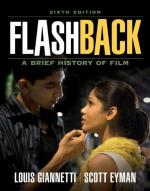
|
| Name: _________________________ | Period: ___________________ |
This test consists of 15 multiple choice questions and 5 short answer questions.
Multiple Choice Questions
1. What region became renowned for their film adaptations of literary classics?
(a) Southern Japan.
(b) USSR.
(c) Eastern Europe.
(d) Scotland.
2. Who revolutionized the way films were shot on-location through such "studios on wheels" such as the Cinemobile Mark IV?
(a) Ingmar Bergman.
(b) Fouad Said.
(c) David Lynch.
(d) Alfred Hitchcock.
3. For what reasons did Japanese films escape censorship from their government in their Golden Age?
(a) Japanese films were naturally conservative.
(b) Japanese films dealt strictly in historical events.
(c) Japanese directors managed to film exclusively outside of their country.
(d) Japanese films were veiled propaganda for the government.
4. Due to the obliteration of the Production Code in the sixties, what type of films became popular in the seventies?
(a) Experimental.
(b) Pornography.
(c) Horror.
(d) Blaxploitation.
5. Which decade is considered the beginning of Japan's Golden Age in cinema?
(a) The sixites.
(b) The forties.
(c) The seventies.
(d) The fifties.
6. What was encouraged by the New Wave filmmakers?
(a) Improvisation.
(b) Song and dance.
(c) Nudity.
(d) Violence.
7. In Eastern Europe in the seventies, what topic was generally avoided in their cinema?
(a) Historical accuracy.
(b) Sexuality.
(c) Politics.
(d) Violence.
8. Which of the following was not one of the major national movements in America during the 1970s?
(a) Marxism.
(b) Nationalism.
(c) Feminism.
(d) Populism.
9. What was the focus of Italy's films in the years around World War II?
(a) Expressionism.
(b) Epics.
(c) Theatrical adaptations.
(d) Neo-realism.
10. What popular American film from the eighties was one of the most successful mixes of both animation and live action?
(a) "Cool World."
(b) "Who Framed Roger Rabbit."
(c) "Fritz the Cat."
(d) "Ghostbusters."
11. What were the primary goal's of German films after World War II?
(a) Entertainment for the masses.
(b) Correcting Nazi propaganda.
(c) Asking other countries for help.
(d) Promoting the country's worth.
12. What was the name of France's sudden revitalization in their film industry in the 1950s?
(a) Golden Era.
(b) Cinema Noir.
(c) New Wave.
(d) Film du Prince.
13. What was the main focus in French cinema in the seventies?
(a) Plot.
(b) Characters.
(c) Dialogue.
(d) Mood.
14. What was the name of the period in England from 1963 to 1970?
(a) Sex Pistol's Penance.
(b) Overt Cockney.
(c) Angry Young Man movement.
(d) Swinging England.
15. What movement is credited with the influx of women in positions of power in the film industry?
(a) Civil rights.
(b) Feminism.
(c) Immigration rights.
(d) Anti-censorship lobbying.
Short Answer Questions
1. Who was the comedic French director that rose to prominence in the 1950s?
2. Which of the following was not one of the main focuses of American cinema in the 1980s?
3. What country nearly wiped out the French film industry after World War II?
4. What genre of film became particularly popular in the early seventies?
5. What declined per America's changing tastes and desire for more sophisticated films in the 1950s?
|
This section contains 447 words (approx. 2 pages at 300 words per page) |

|




